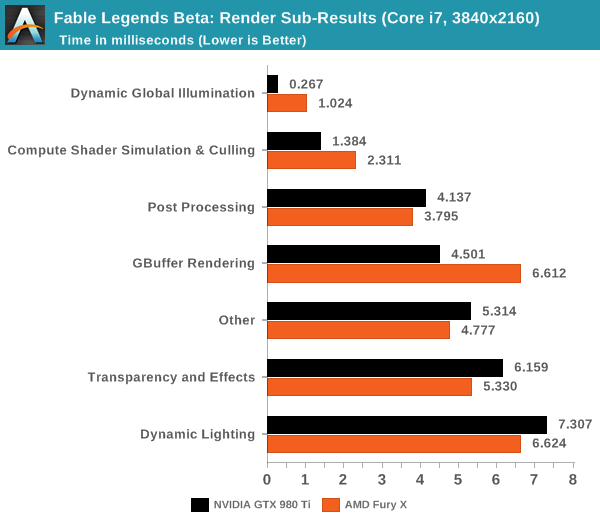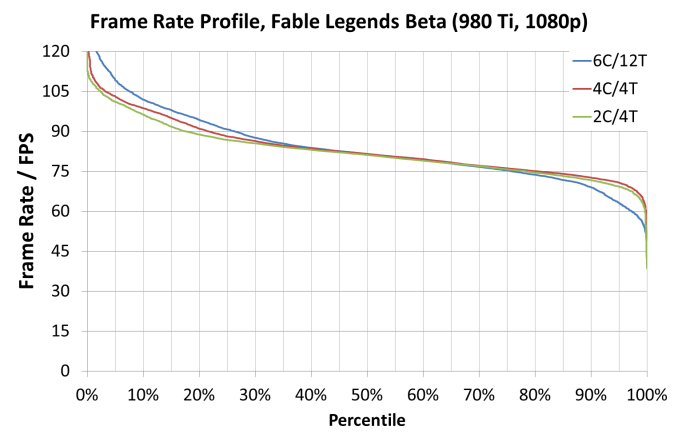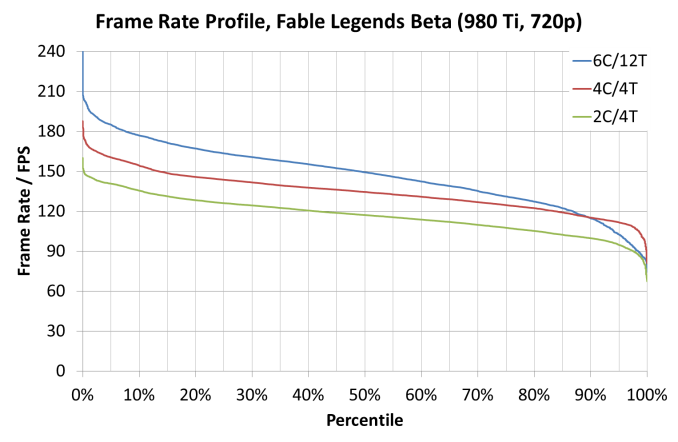Fable Legends Early Preview: DirectX 12 Benchmark Analysis
by Ryan Smith, Ian Cutress & Daniel Williams on September 24, 2015 9:00 AM ESTFinal Words
Non-final benchmarks are a tough element to define. On one hand, they do not show the full range of both performance and graphical enhancements and could be subject to critical rendering paths that cause performance issues. On the other side, they are near-final representations and aspirations of the game developers, with the game engine almost at the point of being comfortable. To say that a preview benchmark is somewhere from 50% to 90% representative of the final product is not much of a bold statement to make in these circumstances, but between those two numbers can be a world of difference.
Fable Legends, developed by Lionhead Studios and published by Microsoft, uses EPIC’s Unreal 4 engine. All the elements of that previous sentence have gravitas in the gaming industry: Fable is a well-known franchise, Lionhead is a successful game developer, Microsoft is Microsoft, and EPIC’s Unreal engines have powered triple-A gaming titles for the best part of two decades. With the right ingredients, therein lies the potential for that melt-in-the-mouth cake as long as the oven is set just right.
Convoluted cake metaphors aside, this article set out to test the new Fable Legends benchmark in DirectX 12. As it stands, the software build we received indicated that the benchmark and game is still in 'early access preview' mode, so improvements may happen down the line. Users are interested in how DX12 games will both perform and scale on different hardware and different settings, and we aimed to fill in some of those blanks today. We used several AMD and NVIDIA GPUs, mainly focusing on NVIDIA’s GTX 980 Ti and AMD’s Fury X, with Core i7-X (six cores with HyperThreading), Core i5 (quad core, no HT) and Core i3 (two cores, HT) system configurations. These two GPUs were also tested at 3840x2160 (4K) with Ultra settings, 1920x1080 with Ultra settings and 1280x720 with low settings.
On pure average frame rate numbers, we saw NVIDIA’s GTX 980 Ti by just under 10% in all configurations except for the 1280x720 settings which gave the Fury X a substantial (10%+ on i5 and i3) lead. Looking at CPU scaling, this showed that scaling only ever really occurred at the 1280x720 settings anyway, with both AMD and NVIDIA showing a 20-25% gain moving from a Core i3 to a Core i7. Some of the older cards showed a smaller 7% improvement over the same test.
Looking through the frame rate profile data, specifically looking for minimum benchmark percentile numbers, we saw an interesting correlation with using a Core i7 (six core, HT) platform and the frame rates on complex frames being beaten by the Core i5 and even the Core i3 setups, despite the fact that during the easier frames to compute the Core i7 performed better. In our graphs, it gave a tilted axis akin to a seesaw:
When comparing the separate compute profile time data provided by the benchmark, it showed that the Core i7 was taking longer for a few of the lighting techniques, perhaps relating to cache or scheduling issues either at the CPU end or the GPU end which was alleviated with fewer cores in the mix. This may come down to a memory controller not being bombarded with higher priority requests causing a shuffle in the data request queue.

When we do a direct comparison for AMD’s Fury X and NVIDIA’s GTX 980 Ti in the render sub-category results for 4K using a Core i7, both AMD and NVIDIA have their strong points in this benchmark. NVIDIA favors illumination, compute shader work and GBuffer rendering where AMD favors post processing, transparency and dynamic lighting.
DirectX 12 is coming in with new effects to make games look better with new features to allow developers to extract performance out of our hardware. Fable Legends uses EPIC’s Unreal Engine 4 with added effects and represents a multi-year effort to develop the engine around DX12's feature set and ultimately improve performance over DX11. With this benchmark we have begun to peek a little in to what actual graphics performance in games might be like, and if DX12 benefits users on low powered CPUs or high-end GPUs more. That being said, there is a good chance that the performance we’ve seen today will change by release due to driver updates and/or optimizing the game code. Nevertheless, at this point it does appear that a reasonably strong card such as the 290X or GTX 970 are needed to get a smooth 1080p experience (at Ultra settings) with this demo.














141 Comments
View All Comments
Traciatim - Thursday, September 24, 2015 - link
RAM generally has very little to no impact on gaming except for a few strange cases (like F1).Though, the machine still has it's cache available so the i3 test isn't quite the same thing as a real i3 it should be close enough that you wouldn't notice the difference.
Mr Perfect - Thursday, September 24, 2015 - link
In the future, could you please include/simulate a 4 core/8 thread CPU? That's probably what most of us have.Oxford Guy - Thursday, September 24, 2015 - link
How about Ashes running on a Fury and a 4.5 GHz FX CPU.Oxford Guy - Thursday, September 24, 2015 - link
and a 290X, of course, paired against a 980vision33r - Thursday, September 24, 2015 - link
Just because a game supports DX12 doesn't mean it uses all DX12 features. It looks like they have DX12 as a check box but not really utilizing DX12 complete features. We have to see more DX12 implemenations to know for sure how each card stack up.Wolfpup - Thursday, September 24, 2015 - link
I'd be curious about a direct X 12 vs 11 test at some point.Regarding Fable Legends, WOW am I disappointed by what it is. I shouldn't be in a sense, I mean I'm not complaining that Mario Baseball isn't a Mario game, but still, a "free" to play deathmatch type game isn't what I want and isn't what I think of with Fable (Even if, again, really this could be good for people who want it, and not a bad use of the license).
Just please don't make a sequel to New Vegas or Mass Effect or Bioshock that's deathmatch LOL
toyotabedzrock - Thursday, September 24, 2015 - link
You should have used the new driver given you where told it was related to this specific game preview.Shellshocked - Thursday, September 24, 2015 - link
Does this benchmark use Async compute?Spencer Andersen - Thursday, September 24, 2015 - link
Negative, Unreal Engine does NOT use Async compute except on Xbox One. Considering that is one of the main features of the newer APIs, what does that tell you? Nvidia+Unreal Engine=BFF But I don't see it as a big deal considering that Frostbite and likely other engines already have most if not all DX12 features built in including Async compute.Great article guys, looking forward to more DX12 benchmarks. It's an interesting time in gaming to say the least!
oyabun - Thursday, September 24, 2015 - link
There is something wrong with the webpages of the article, an ad by Samsung seems to cover the entire page and messes up all the rendering. Furthermore wherever I click a new tab opens at www.space.com! I had to reload several times just to be able to post this!